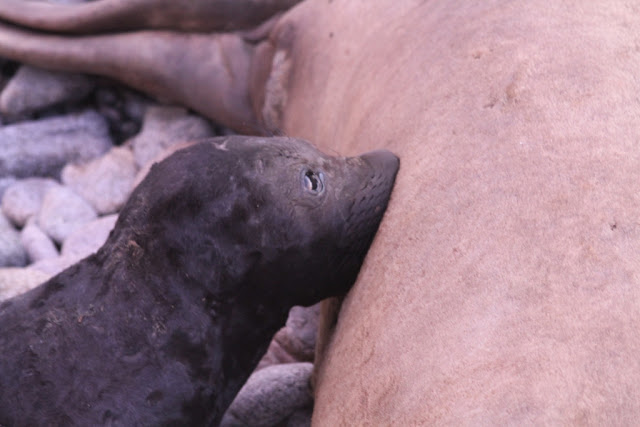The elephant seal season is now at its full peak. When we first arrived in early December, the majority of elephant seal haul-out sites were occupied by molting immature seals and resting sea lions. These animals soon made way for the arriving pregnant and cantankerous elephant seal cows and aggressive males which have been vying for access to the ladies.
 |
| Elephant seal bull and California sea lions |
Northern elephant seals (Mirounga angustirostris) have a truly extreme, pelagic lifestyle. They spend most of their time at sea (8-10 months), coming ashore briefly twice a year: to molt in the summer/fall and to give birth to pups and mate in the winter/spring. Unlike other pinniped species which go in and out of the water to forage and cool off during the breeding season, elephant seals remain on land during the entirety of the breeding season - over a month for cows and up to 3 months for the dominant bulls. During this time, the animals expend an incredible amount of energy while rearing their young and battling for breeding rights, all while fasting. Elephant seals have a highly polygynous social structure during breeding season, with one dominant bull controlling a territory with access to 50 or more females, all of whom he will mate with at the end of the season. Not surprisingly, the males battle violently, sometimes to the death, to control or usurp these territories. The cows, in turn, tend to haul out in areas controlled by the most dominant male, which protects them and their pups from harassment by younger, inexperienced males and serves as a mate with the most genetic fitness.
 |
| Alpha male and his harem, after a recent pup birth |
 |
| A cow's flipper tag |
The Sand Flat alpha bull for the past 3 years, named Rusty, hauled out on the rookery on December 8. Other bulls arrived several weeks later and began protecting smaller territories as they’ve done for the past several years, including Herzog (at Omega Terrace and Marine Terrace) and MC Hammer (at Mirounga Beach). Rusty has mostly exhibited minor dominance displays, involving bluff charges, upright posturing, short chases, and rumbling vocalizations that have resulted in all other subordinate males quickly backing down, demonstrating that he is clearly the big man on SEFI. This would be his fourth year as alpha male on Sand Flat.
On average, most males cannot maintain alpha status for more than 4 years due to the massive energy expenditure associated with battles while protecting a territory. We're keen to see who Rusty's successor will be, and when he will take over the harem.
 |
| Rusty, alpha bull of Sand Flat |
On average, most males cannot maintain alpha status for more than 4 years due to the massive energy expenditure associated with battles while protecting a territory. We're keen to see who Rusty's successor will be, and when he will take over the harem.
 |
| Herzog threatening a young intruder male |
The first cow arrived at Sand Flat on December 7, and the first elephant seal pup of the season was born on Dec 21st. Our second pup was born to Alizabeth on Dec 27, a cow with tags from the Ano Nuevo rookery that also pupped here last year. Unfortunately, last season Alizabeth was either separated from or abandoned her pup after a brief nursing period, causing it to starve on its own. She was a much better mother this year - she nursed and fiercely protected this season’s pup for 30 days, leaving behind a plump, healthy weanling (known colloquially as ‘weaner’). After a mostly quiet first month, pregnant cows began arriving in droves and most pupped within the first two weeks of January. We were lucky to witness a number of births - always an amazing experience since the newborns are about 4 feet in length and weigh an average of 80 lbs!
We’ve seen a number of familiar cows that were here last year, such as Lodi, Gypsy, Maddy, Shaye, Whoops, Ariane, and Robin Robertson, among others. Interestingly, 4-year old Rose had her first pup alongside her 12-year old mother, Maddy, on Sand Flat. They have both successfully nursed and protected their pups to weaning.
 |
| Weaners play-fighting |
Some of the weaners are discovering water for the first time in a stagnant rain puddle, rolling around, splashing, and blowing bubbles under the surface.
They will stay in the area for at least a month, until they lose enough weight and gain enough coordination and appetite for their first foraging trips to sea. One of the first pups to wean, which was born on December 27 to 12-year old Kyra, has decided to reject this required fasting period. Instead, he has found a surrogate mother in Ivy, who was separated from her own pup which perished during some of the male battles a few weeks ago. This hungry pup has the capacity to balloon to up to 600 pounds (most pups are 200-300 lbs at weaning) and become what is known as a 'superweaner,' or 'double mother suckler.'
 |
| 'Superweaner' with Ivy, his second mother |
Stay tuned to find out how big Superweaner will grow, how many pups make it to weaning this season, and who will reign supreme king of Sand Flat!





1 comment:
That top photo is aching for some silly captions. It looks like a teacher with her class.
The rest are wonderful with the new pups.
nellie
Post a Comment